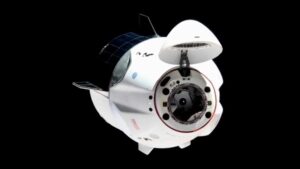The Ax-1 mission, announced in January, will fly three paying customers on a SpaceX Crew Dragon spacecraft commanded by former NASA astronaut Michael López-Alegría.
Preparations for the mission are underway, NASA and Axiom officials said at a briefing. The three people joining López-Alegría on Ax-1 — Larry Connor, Mark Pathy, and Eytan Stibbe — will undergo centrifuge and zero-g training next week. López-Alegría said he will start full-time training for the mission in August. Connor, designated as the pilot for the mission, will start training in September, with Pathy and Stibbe to follow in October.
The mission will last 10 days, including seven to eight docked to the ISS. Michael Suffredini, president and chief executive of Axiom Space, said preparations for the mission were on schedule. “We have a high degree of confidence in the late January date” for launching Ax-1, he said.
That mission is the first in a series Axiom Space plans to fly to the ISS as it develops a series of commercial modules it will add to the station beginning as soon as 2024, which themselves will be the core of a future stand-alone space station. “We’ve got things lined up for next three flights, Ax-2, 3 and 4,” he said. “We still have to work with NASA to figure out exactly when those flights can come to the ISS.”
Those private astronaut missions are enabled by NASA’s low Earth orbit commercialization policy announced nearly two years ago, which allows two such missions a year and also sets aside resources on the ISS for commercial applications. Axiom is the first company to sign an agreement with NASA for a private astronaut mission, but the agency said it’s seeing strong interest in general for such missions.
“We are seeing a lot of interest in private astronaut missions, even outside of Axiom,” said Angela Hart, manager of commercial low Earth orbit development at NASA’s Johnson Space Center. “At this point, the demand exceeds what we actually believe the opportunities on station will be.”
Opportunities for private astronaut missions are limited by what NASA calls the “traffic model” for the ISS, or the schedule of vehicles arriving and departing the station. Commercial crew missions are limited to two docking ports on the station, one of which is occupied by the vehicle that transported the current long-duration crew on the station. The other is used by commercial crew vehicles during crew handovers, cargo Dragon missions and private astronaut missions.
That restricts the opportunities for private astronaut missions. “About two is about all you fit in there with the rest of the traffic,” Dana Weigel, deputy manager of the ISS program at JSC, said.
Axiom hopes to seize those opportunities, with Suffredini stating that his company would like to fly private astronaut missions at the rate of two per year. “We’re prepared to fly on a cadence of about twice a year, but like everyone, we have to compete for the opportunity,” he said.
NASA recently changed the pricing policy for private astronaut missions, significantly increasing the prices it charges companies seeking to fly such missions to cover “full reimbursement for the value of NASA resources” used to support them. However, the agreement for Ax-1 was completed under the 2019 pricing policy.
Thanks to an exchange of services between NASA and Axiom, it will actually be NASA paying Axiom for the Ax-1 mission. While Axiom is acquiring services such as crew supplies and on-orbit resources, NASA will be purchasing “cold stowage” space on the Crew Dragon spacecraft to return cargo to Earth at the end of the mission. NASA will pay Axiom $1.69 million for the mission, although Hart noted there will be other charges to Axiom for training and launch services, some of which are still being negotiated.
Suffredini said that, on later missions, Axiom will seek to reduce its reliance on NASA services. “We have a goal that, by after our third flight, we will provide all of those kinds of capabilities” that it is currently purchasing from NASA.
Phil McAlister, director of commercial spaceflight development at NASA Headquarters, said the Axiom agreement was the latest sign of a burgeoning commercial human spaceflight industry, which includes the series of Crew Dragon missions to the ISS, the planned Inspiration4 mission this fall and suborbital spaceflight activities by Blue Origin and Virgin Galactic.
“This truly is a renaissance in U.S. human spaceflight. I think that’s the perfect word for what we’re experiencing,” he said. “It’s just what we envisioned for the commercial crew program when we embarked on that about 10 years ago.”



